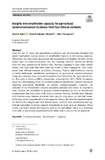| dc.contributor.author | Saha, Amrita | |
| dc.contributor.author | Sabates-Wheeler, Rachel | |
| dc.contributor.author | Thompson, John | |
| dc.coverage.spatial | Africa | en |
| dc.coverage.spatial | Ghana | en |
| dc.coverage.spatial | Tanzania | en |
| dc.coverage.spatial | Nigeria | en |
| dc.coverage.spatial | Zimbabwe | en |
| dc.date.accessioned | 2021-07-20T10:33:30Z | |
| dc.date.available | 2021-07-20T10:33:30Z | |
| dc.date.issued | 2021-07-13 | |
| dc.identifier.citation | Saha, A.; Sabates‑Wheeler, R. and Thompson, J. (2021) 'Insights into Smallholder Capacity for Agricultural Commercialisation: Evidence from Four African Contexts', The European Journal of Development Research, DOI: 10.1057/s41287-021-00414-z | en |
| dc.identifier.uri | https://opendocs.ids.ac.uk/opendocs/handle/20.500.12413/16749 | |
| dc.description.abstract | Over the last 15 years, the agricultural economics and development literature has amply highlighted success stories of smallholder farmers in developing countries, illustrating their increased engagement and integration with markets, in other words, higher rates of commercialisation. Yet, this seeming ‘success’ should not detract from the large proportion of farmers who, through engaging in high-value market chains, face high risks that often limit the extent of their engagement. This study, across four African contexts in Ghana, Tanzania, Nigeria and Zimbabwe, strives to better understand smallholder participation in agricultural commercialisation. Using new detailed cross-sectional household-level data, from the Agricultural Policy Research in Africa (APRA) consortium, collected over 2017–2018, we analyse assets as a determining factor for localised patterns smallholder commercialisation. Applying asset-based thresholds, we capture commercialisation ‘capacity’—an indicator of the household’s commercialisation potential and ability to respond to risks. Despite the possibility to increase commercialisation as well as institutional arrangements that may reduce risk, such as contract farming, benefits from linkages with medium-scale farmers or returns from specific crop types, we find that households may yet be constrained by lower capacity. Hence, the need for targeted support for those at the margins and with limited assets; with the most pronounced and significant constraints for lower capacity households in study areas in Tanzania. These results can better inform development policies for agriculture where it is important to be able to specifically target households rather than a one size fits all approach. | en |
| dc.language.iso | en | en |
| dc.publisher | Springer Link | en |
| dc.relation.ispartofseries | The European Journal of Development Research; | |
| dc.rights.uri | http://creativecommons.org/licenses/by/4.0/ | en |
| dc.subject | Agriculture | en |
| dc.subject | Economic Development | en |
| dc.subject | Participation | en |
| dc.title | Insights into Smallholder Capacity for Agricultural Commercialisation: Evidence from Four African Contexts | en |
| dc.type | Article | en |
| dc.rights.holder | © The Author(s) 2021 | en |
| dc.identifier.externaluri | https://link.springer.com/article/10.1057/s41287-021-00414-z#citeas | en |
| dc.identifier.team | Rural Futures | en |
| dc.identifier.doi | 10.1057/s41287-021-00414-z | |
| dcterms.dateAccepted | 2021-05-17 | |
| rioxxterms.funder | Default funder | en |
| rioxxterms.identifier.project | Default project | en |
| rioxxterms.version | VoR | en |
| rioxxterms.versionofrecord | 10.1057/s41287-021-00414-z | en |
| rioxxterms.funder.project | 9ce4e4dc-26e9-4d78-96e9-15e4dcac0642 | en |


